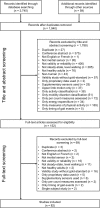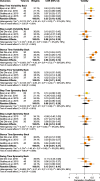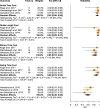Validity and reliability of wearable inertial sensors in healthy adult walking: a systematic review and meta-analysis
- PMID: 32393301
- PMCID: PMC7216606
- DOI: 10.1186/s12984-020-00685-3
Validity and reliability of wearable inertial sensors in healthy adult walking: a systematic review and meta-analysis
Abstract
Background: Inertial measurement units (IMUs) offer the ability to measure walking gait through a variety of biomechanical outcomes (e.g., spatiotemporal, kinematics, other). Although many studies have assessed their validity and reliability, there remains no quantitive summary of this vast body of literature. Therefore, we aimed to conduct a systematic review and meta-analysis to determine the i) concurrent validity and ii) test-retest reliability of IMUs for measuring biomechanical gait outcomes during level walking in healthy adults.
Methods: Five electronic databases were searched for journal articles assessing the validity or reliability of IMUs during healthy adult walking. Two reviewers screened titles, abstracts, and full texts for studies to be included, before two reviewers examined the methodological quality of all included studies. When sufficient data were present for a given biomechanical outcome, data were meta-analyzed on Pearson correlation coefficients (r) or intraclass correlation coefficients (ICC) for validity and reliability, respectively. Alternatively, qualitative summaries of outcomes were conducted on those that could not be meta-analyzed.
Results: A total of 82 articles, assessing the validity or reliability of over 100 outcomes, were included in this review. Seventeen biomechanical outcomes, primarily spatiotemporal parameters, were meta-analyzed. The validity and reliability of step and stride times were found to be excellent. Similarly, the validity and reliability of step and stride length, as well as swing and stance time, were found to be good to excellent. Alternatively, spatiotemporal parameter variability and symmetry displayed poor to moderate validity and reliability. IMUs were also found to display moderate reliability for the assessment of local dynamic stability during walking. The remaining biomechanical outcomes were qualitatively summarized to provide a variety of recommendations for future IMU research.
Conclusions: The findings of this review demonstrate the excellent validity and reliability of IMUs for mean spatiotemporal parameters during walking, but caution the use of spatiotemporal variability and symmetry metrics without strict protocol. Further, this work tentatively supports the use of IMUs for joint angle measurement and other biomechanical outcomes such as stability, regularity, and segmental accelerations. Unfortunately, the strength of these recommendations are limited based on the lack of high-quality studies for each outcome, with underpowered and/or unjustified sample sizes (sample size median 12; range: 2-95) being the primary limitation.
Keywords: Biomechanics; Gait; Inertial measurement units; Inertial sensors; Reliability; Review; Validity.
Conflict of interest statement
We have no competing interests to declare.
Figures





References
Publication types
MeSH terms
Grants and funding
LinkOut - more resources
Full Text Sources

